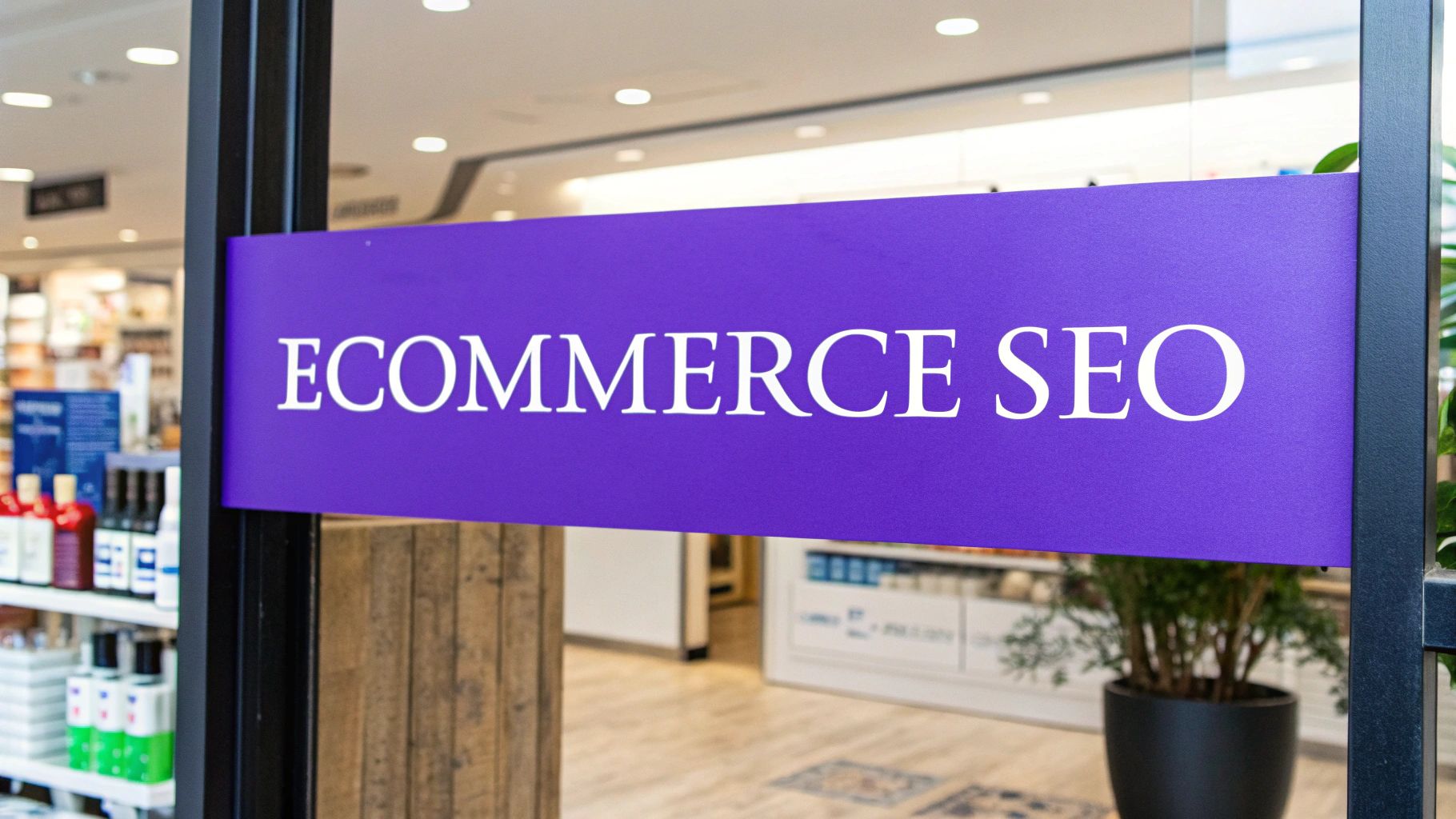Ultimate Guide to Ecommerce SEO Best Practices: Transform Your Store's Search Performance

Navigating the Complex World of Ecommerce SEO

Online stores need specialized SEO tactics to succeed. Unlike traditional websites, ecommerce sites face distinct challenges in managing large product catalogs, handling dynamic content, and driving sales conversions. Basic SEO practices alone often won't cut it - understanding ecommerce-specific SEO strategies is essential for getting more organic traffic that converts into sales.
Why Traditional SEO Falls Short for Ecommerce
While standard SEO typically focuses on broad informational content, ecommerce sites need to attract people ready to buy. For instance, a garden blog might target "how to care for houseplants," but an online plant store needs to reach shoppers searching "buy monstera deliciosa plant." This key difference affects everything from keyword choices to content strategy. Plus, ecommerce sites must effectively organize and optimize hundreds or thousands of product pages - a challenge that most regular websites don't face.
Key Components of Ecommerce SEO
Getting ecommerce SEO right requires mastering several core elements that work together to improve both search rankings and user experience:
Technical Foundation: Your site needs to be easy for search engines to crawl and index. This means having fast page speeds, a clear site structure, and proper technical setup. When pages load quickly and navigation works smoothly, customers are more likely to stick around and buy.
Smart Keyword Research: Focus on product-specific terms that show buying intent, like "organic bamboo sheets queen size." These longer, detailed phrases help you connect with shoppers who know what they want.
Product Page Optimization: Every product page needs compelling titles, detailed descriptions, and high-quality images that incorporate relevant keywords naturally. The content should thoroughly explain what makes each product unique and valuable.
Helpful Content: Create buying guides, comparison articles, and other content that helps customers make purchase decisions. A detailed guide on "How to Measure for Curtains" can attract potential customers shopping for window treatments.
Smooth Shopping Experience: Make it easy for customers to find products, get information, and complete their purchase. Clear navigation, detailed product specs, and a hassle-free checkout process keep shoppers happy and improve your search rankings.
Maintaining a Competitive Edge
Success in ecommerce SEO requires constant attention and adjustment. Keep track of important metrics like organic traffic, sales conversions, and average order size to understand what's working. Use this data to spot opportunities for improvement and adjust your strategy as needed. Regular monitoring and updates help ensure your online store stays visible and competitive as shopping habits and search algorithms change.
Strategic Keyword Research for Revenue Growth

Good keyword research makes or breaks an ecommerce SEO strategy. But finding popular search terms is just the start - you need to understand why people search for certain terms and how that connects to your products and customers. The goal is attracting ready-to-buy visitors, not just casual browsers. Recent data shows that 75% of B2C marketers rely on keyword research tools when creating content, according to SEO Statistics. This highlights just how essential keyword research is for SEO success.
Mapping Keywords to the Customer Journey
Smart ecommerce brands match their keywords to each stage of the customer journey. Picture it like a funnel: At the top, people search for general information ("benefits of organic cotton sheets"). In the middle, they compare options ("best organic cotton sheet brands"). At the bottom, they're ready to buy ("buy organic cotton sheets online"). By targeting all these stages, you guide potential customers from initial interest to final purchase.
Optimizing for Purchase Intent
Want to boost sales? Focus on keywords that show someone is ready to buy - these have high purchase intent. Look for terms with words like "buy," "shop," "price," "discount," or specific product details like model numbers. When you rank for these keywords, you put your products in front of people who are actively looking to make a purchase.
Identifying Untapped Opportunities
Keep an eye on what keywords your competitors rank for - you might find valuable opportunities they've missed. Pay special attention to long-tail keywords, which are longer and more specific search phrases. For example, rather than just targeting "shoes," you might focus on "women's waterproof hiking boots size 8." These specific terms often lead to higher sales since shoppers know exactly what they want.
Maintaining Keyword Relevance
Search trends change as customer needs shift. Stay on top of your keyword strategy by regularly checking search volumes, finding new relevant terms, and removing keywords that no longer perform well. Tools like Google Trends help track these changes in search patterns. Being flexible and data-driven helps keep your SEO strategy fresh and effective.
Building a Search-Optimized Store Architecture

Think of your online store's structure like a well-organized retail shop - customers should easily find what they're looking for, and search engines should understand how everything connects. When you build your site architecture thoughtfully, you create the foundation for both better search visibility and higher sales.
Creating Effective Category Hierarchies
Just as a physical store organizes products by department and section, your online store needs clear product groupings. Set up your categories in a way that makes sense to shoppers - for example, a fashion site might start with broad sections like "Women's Clothing" then break down into specific types like "Dresses" and "Tops." This clear structure helps both customers and search engines navigate your site efficiently.
Mastering Internal Links for Better Discovery
The way you connect pages on your site is crucial for helping people explore your products. Think of internal links as helpful signs guiding shoppers to related items they might like. For instance, link from a product page to matching accessories, or connect blog posts about summer fashion to your seasonal collections. This approach helps spread search ranking power across your site while encouraging customers to browse more.
Optimizing Site Speed for Sales
Nobody likes a slow website, especially shoppers ready to buy. In fact, studies show that 40% of people leave a site that takes more than 3 seconds to load. Focus on key speed improvements like:
- Compressing product images without losing quality
- Using efficient coding practices
- Setting up proper browser caching
- Optimizing for mobile devices first
These technical improvements directly impact both your search rankings and your conversion rates. MonsterInsights has found that faster sites consistently perform better in search results.
Scaling Your Technical SEO
As your product catalog grows, maintaining good site structure becomes even more important. Put systems in place early to handle expansion:
- Create consistent URL patterns for new categories
- Build automated internal linking rules
- Set up monitoring for site speed and errors
- Use XML sitemaps to help search engines find new content
This foundation ensures your store can grow smoothly while maintaining strong search performance. Remember to regularly check your technical SEO health and make adjustments as needed to support your expanding business.
Mastering Product Page Optimization

Product pages can make or break your online store's success. As the key place where customers make purchase decisions, these pages need to work hard - both to attract search traffic and turn browsers into buyers. Let's explore proven ways to optimize your product pages for maximum impact.
Crafting Compelling Product Descriptions
Great product descriptions do more than list basic specs - they tell a story that connects with customers. Focus on explaining how the product solves real problems and improves lives. For example, instead of just saying "Cotton t-shirt", paint a picture: "Stay cool and comfortable all day in our soft, breathable cotton tee." Add relevant keywords naturally within engaging copy that speaks to your customers' needs.
Implementing Structured Data for Rich Snippets
Structured data helps search engines better understand your product information. When implemented correctly, this can lead to rich snippets - enhanced search results showing ratings, prices, and availability right in search results. These eye-catching listings typically see higher click rates compared to basic text results, giving you an edge over competitors who haven't added structured data.
Leveraging Customer Reviews for SEO Success
Customer reviews build trust and credibility while providing fresh content that search engines love. Make it easy for buyers to leave detailed feedback about their purchases. Take time to respond thoughtfully to both positive and negative reviews - this shows you value customer input while creating more relevant content for your pages. According to recent data, product pages with customer reviews see significantly better conversion rates. Learn more about the impact of reviews in these detailed SEO statistics.
Scaling Optimization Across Large Catalogs
When you have hundreds or thousands of products, optimization can feel overwhelming. Create clear guidelines for your product content, including keyword usage and formatting standards. While templates help maintain consistency, avoid duplicating content across pages. Instead, highlight what makes each product unique to maintain quality at scale.
Avoiding Common Product Page Mistakes
Watch out for these common pitfalls that can hurt your product page performance: skimpy descriptions that provide little value, duplicate content copied from manufacturers, and low-quality images that fail to showcase products properly. Regular content audits help identify and fix these issues before they impact your results.
Frameworks for Scaling Optimization
Build a systematic process for keeping product pages fresh and effective, especially with large catalogs. This might include using a content management system with built-in SEO tools or creating clear workflows for content updates. Regular reviews ensure information stays accurate and relevant for both customers and search engines, helping maintain strong organic visibility over time.
Developing Content That Drives Ecommerce Growth
Good content is essential for ecommerce success. It helps you connect with people searching online and turn them into repeat customers. The most successful online stores know this well - they create helpful content that both ranks in search results and guides shoppers toward making purchases.
Building Engaging Category Pages
Category pages deserve more attention than they usually get. Rather than just showing product listings, treat them as landing pages that help customers learn about different product types. Add useful information about the category itself to help shoppers find exactly what they need. Let's say you have a "Running Shoes" category - you could explain different shoe types for various running styles and surfaces. This naturally includes relevant keywords while making the page more helpful for visitors.
Creating Valuable Buying Guides
Buying guides are excellent tools that show customers you know your stuff. Focus these guides on solving specific problems shoppers face when choosing products. For example, a furniture store might write "How to Choose the Perfect Sofa for Your Space" to help customers make smart decisions while highlighting relevant items. This builds credibility and keeps people coming back to your store for advice.
Developing a Blog Strategy for Ecommerce Authority
A strong blog can really boost your store's visibility in search results. Write about topics that matter to your customers - product reviews, how-to articles, and stories about your brand. Just be sure to post quality content consistently. This keeps your site fresh with new information, brings in potential customers through search, and shows that you're an expert in your field.
Identifying Content Opportunities Your Competitors Are Missing
Look for gaps in the information that's already out there. Are there questions your competitors haven't answered yet? Maybe there's a product comparison no one has written about, or a common customer problem that needs solving. When you spot these opportunities and create helpful content around them, you can attract people searching for those specific answers. This helps establish your store as the go-to source for both information and products in your market.
Measuring and Scaling SEO Success
It's time to understand how well your ecommerce SEO efforts are paying off and plan for future growth. Success comes from focusing on the right numbers and adapting as your business expands.
Identifying the Right KPIs
Don't get distracted by surface-level metrics like raw traffic numbers. The key metrics that really matter are the ones tied directly to your bottom line:
- Organic Traffic Quality: Look at how many organic visitors actually buy something. This shows if you're attracting the right audience through SEO.
- Average Order Value (AOV): When organic visitors spend more per order, it means your SEO brings in valuable customers. Good product pages and internal linking help boost AOV.
- Conversion Rate: Track how many organic visitors become customers. Rising conversion rates show your site effectively guides people to purchase.
- Buy-Ready Keyword Rankings: Target and track keywords used by people ready to make a purchase. Ranking well for these terms puts you in front of motivated buyers.
- Return on Investment (ROI): Compare what you spend on SEO versus the revenue it generates. This tells you if your efforts are worthwhile.
Monitoring Search Visibility and Algorithm Updates
Keep an eye on your keyword rankings over time to see if your optimization work pays off. Stay informed about Google's algorithm changes so you can adapt quickly and avoid ranking drops. Google Search Console gives you vital data to track performance and spot improvement opportunities.
Scaling Your SEO Strategies
As your store grows, your SEO needs to grow with it. Create clear guidelines for optimizing new product pages. Consider tools to help with structured data and image optimization. Build out a content calendar and think about working with writers or designers to scale up content creation.
Avoiding Common Measurement Mistakes
Don't focus too heavily on any single metric like total organic traffic. Make sure to dig into why your numbers change - both good and bad. Regular analysis of user behavior, keyword performance, and algorithm updates helps you make smart adjustments to keep growing.
Looking for help turning your Etsy shop into a thriving independent online store? Wand Websites can help. We provide expert design, proven strategies, and ongoing support to boost your sales and free you from marketplace restrictions.


